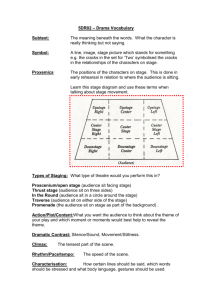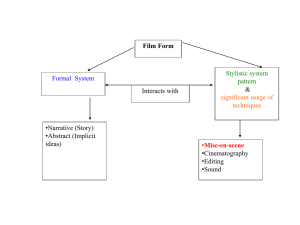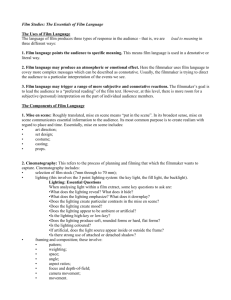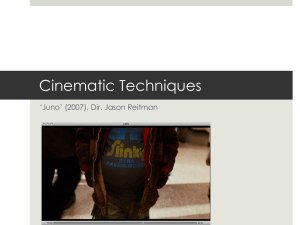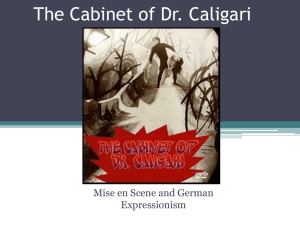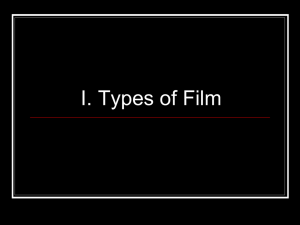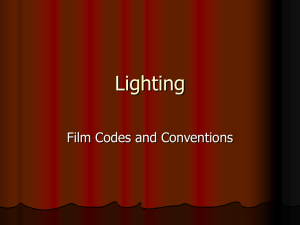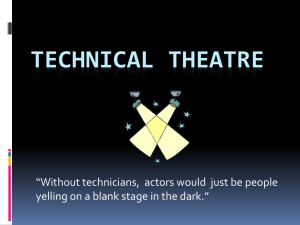Mise-en-Scene - Rossett School
advertisement
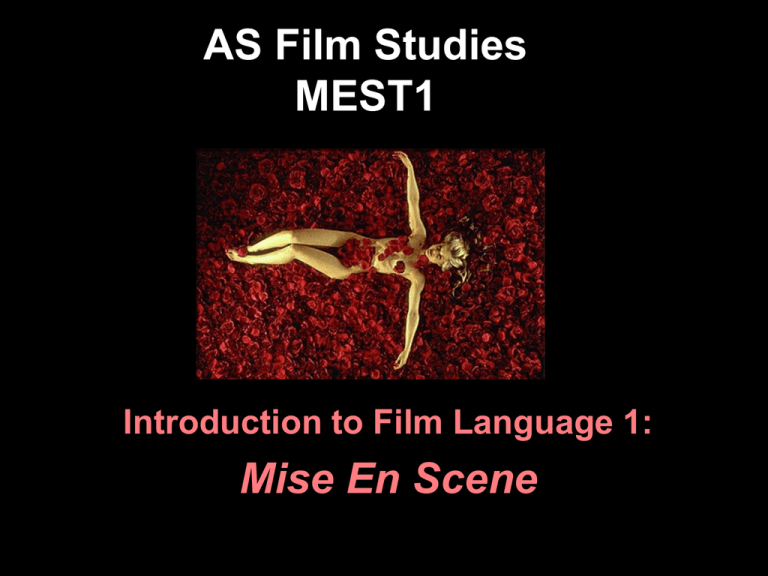
AS Film Studies MEST1 Introduction to Film Language 1: Mise En Scene Session Aims By the end of the session you will be able to: • Understand the concept of ‘mise en scene’ • Apply the concept to a television extract Definition: Mise En Scene • A French term meaning what is put into a scene or frame • Visual information in front of the camera • Communicates essential information to the audience • Made up of 5 elements: Can you guess what they are? The 5 Elements of Mise en Scene • Settings & Props • Costume, Hair & Make Up Each aspect of mise-enscene has hidden meanings within a film and sends signals to the audience about how we are supposed to feel at a certain point • Facial Expressions & Body Language • Lighting & Colour • Positioning of characters/objects within the frame 1. Settings & Props • Settings & Locations play an important part in filmmaking and are not just ‘backgrounds’ • Sets are either built from scratch or a great deal of time is spent to find a setting which already exists • Settings can manipulate an audience by building certain expectations and then taking a different turn • 1. 2. 3. TASK: What settings and props you would find in: A Science Fiction Film A Romantic Comedy A Horror Film 2. Costume, Hair & Make Up • Costume, Hair & Make Up act as an instant indicator to us of a character’s personality, status & job • It tells us immediately whether the film is set in the present and what society/or culture it will centre around • Certain costumes can signify certain individuals (i.e. black cloak of a vampire, Spidey’s Spiderman suit) 3. Facial Expressions & Body Language • Facial Expressions provide a clear indicator of how someone is feeling • If someone is smiling broadly, we assume they are happy but we may get a different feeling if this is accompanied by scary music • Body Language may also indicate how a character feels towards another character or may reflect the state of their relationship • TASK: What meanings/emotions do the following images convey: IMAGE 1 IMAGE 2 IMAGE 3 4. Positioning of Characters & Objects within a frame • Positioning within a frame can draw our attention to an important character/object • A film-maker can use positioning to indicate relationships between people • TASK: What does the positioning in the following images reveal about the characters/film: IMAGE 1 IMAGE 2 IMAGE 3 IMAGE 4 Colour • Colour carries certain connotations which may add meaning to a scene (i.e. Red = Danger/Passion) • Can give a scene a particular look, feel or mood • Can be used for dramatic effect Analysing Mise en Scene 5. Lighting & Colour Lighting & Colour can be used to achieve a variety of effects: • To highlight important characters or objects within the frame • To make characters look mysterious by shading sections of the face & body • To reflect a characters mental state/hidden emotions (i.e. bright = happy, dark = disturbed, strobe effect = confused Types of Lighting • LOW KEY LIGHTING: • Created by using only the key & back lights • Produces sharp contrasts of light and dark areas • Deep, distinct shadows/silhouettes are formed Example: Horror Films Types of Lighting • HIGH KEY LIGHTING: • More filler lights are used. Lighting is natural and realistic to our eyes • Produces brightly lit sets or a sunny day (right) Example: Rom-Coms What types of lighting are used in the following images: B A D E C F TASK: For each image, answer the following questions: 1. What type of lighting is used in each image (High or Low Key)? 2. Where are the KEY LIGHTS, FILLER LIGHTS & BACK LIGHTS in each image? 3. What effects/meanings does the lighting suggest? BACK LIGHT FILLER LIGHTS KEY LIGHT
